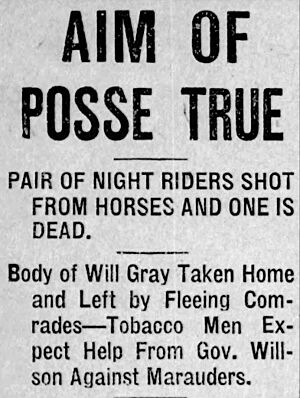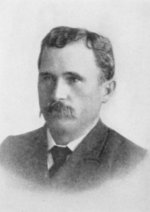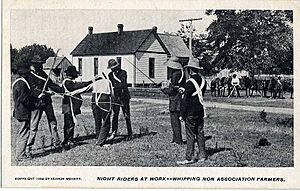The Night Riders facts for kids
The Night Riders were a group of tobacco farmers in Kentucky and Tennessee. They formed in the early 1900s to fight against the American Tobacco Company (ATC). This company, owned by James B. Duke, had a huge control over the tobacco market. They were paying farmers very low prices for their crops.
On September 24, 1904, farmers in western Kentucky and parts of Tennessee created the Planters' Protective Association (PPA). This group, also called "the Association," asked farmers to stop selling their tobacco to the ATC. They wanted to force the company to pay fair prices. A more active group of farmers, led by Dr. David A. Amoss, became known as the Night Riders. They got this name because they often acted at night. They destroyed tobacco warehouses owned by the ATC and sometimes took strong actions against people who didn't support their cause. One of their biggest actions was in Hopkinsville, Kentucky, in 1907.
Contents
The Tobacco War: A Big Fight
The conflict between tobacco farmers and the American Tobacco Company is known as the Black Patch Tobacco Wars. It happened in southwestern Kentucky and northern Tennessee from 1904 to 1909. This was one of the longest and most intense conflicts in the United States between the American Civil War and the civil rights movement of the 1960s.
The Night Riders were a powerful force. They were against the American Tobacco Company because it paid so little for tobacco. Farmers could not make any money from their hard work. Dr. David Amoss, a doctor and farmer, was a leader of the Night Riders. He was later put on trial for his role in the 1907 attack on Hopkinsville, Kentucky. The Amoss House in Caldwell County, Kentucky, later became a museum. It helped share the history of Amoss and the Night Riders. Other museums in the area also have items and stories from this time.
Why Farmers Fought Back
The main reason for the Black Patch Wars was the very low prices offered by the American Tobacco Company. In the late 1800s, farmers earned a good profit from their tobacco. This was enough for a comfortable life.
However, things changed around 1900. The American Tobacco Company became very powerful, almost a monopoly. This meant they had little competition. From 1901 to 1903, the ATC paid only about four cents per pound for tobacco. This was less than what it cost farmers to grow the tobacco! Farmers were losing money just by planting their crops. In some places, the price dropped to as low as one or two cents a pound.
To fight this, farmers created the Planters' Protective Association. Their leader, Felix G. Ewing, had a plan. Farmers would grow tobacco but store it in the Association's warehouses. They would wait until the market price went up. Ewing said that all tobacco growers needed to work together for this plan to succeed.
The Planters' Protective Association and Its Challenges
The Planters' Protective Association (PPA) was formed in 1904. Its goal was to help farmers sell their tobacco for a fair price. They aimed for eight cents per pound, which was two cents more than the cost to grow it. The Association would store the tobacco and pay farmers when it was sold.
At first, many farmers joined the PPA. In some areas, 70% to 95% of farmers agreed to sell their crops only to the Association. However, in the first year, some farmers did not keep their promise. They sold their tobacco to the American Tobacco Company instead. The ATC offered higher prices (ten to twelve cents a pound) to try and break the Association. For example, in 1906, farmers who were not part of the Association got more money than those who were.
To fix this problem, members of the Association met. They decided that some members would become "Possum Hunters." These groups would visit farmers who were not members. They wanted to convince them to join the Association and make it stronger. These night meetings eventually led to the actions of the Masked Silent Brigade, or the Night Riders.
The American Tobacco Company's Role
The American Tobacco Company, also known as the Tobacco Trust, was a very large and powerful company in the late 1890s. It controlled much of the tobacco industry.
When the ATC refused to buy the burley tobacco crop in 1906 and 1907, farmers took strong actions. In 1908, more than 35,000 farmers in over 30 counties did not plant tobacco at all. This meant an entire year's crop was lost. Because of this, the ATC finally agreed to the farmers' demands in November 1908.
Night Rider Actions
The Night Riders began to attack farms and crops if farmers did not support the Association. Large groups of armed Night Riders even took over some towns. They destroyed tobacco stored in Trust warehouses, along with the buildings and machines. They also targeted individuals who supported the Tobacco Trust. The Night Riders were known for being very organized.
By 1908, the Association had gained almost complete control of the Dark Leaf tobacco crop. The Night Riders achieved this success through strong, sometimes illegal, actions. To protect themselves from the government, some Night Riders even got elected to local offices in the affected areas. They gained control of important positions in the counties. However, lawyers for some victims began to move their cases to federal courts. This helped to break the Night Riders' power in local courts and brought them under the law.
Later Tobacco Farmer Efforts
In the 1920s, another group called the Burley Tobacco Growers Cooperative Association tried to deal with a powerful buyer. They also faced a big drop in the price of Bright Leaf Tobacco, similar to what the Dark Patch growers had experienced. Many farmers joined this Burley Association. They promised to sell their crops only to the Association. This helped them gather all the tobacco to negotiate better prices with the large companies.
The Burley Association would hold onto the crop and sell it at a good price. Then, they would pay the farmers. This plan worked well at first. However, the large companies later reduced the price they paid to the Association and its members.
See also
- Vigilantism in the United States of America




